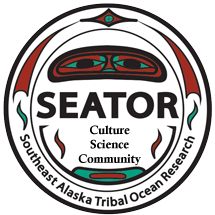Home > SEATOR
SEATOR
The Southeast Alaska Tribal Ocean Research (SEATOR) network was formed in September 2013 to coordinate Southeast Alaskan Tribal responses to the threat of toxic shellfish and harmful algal blooms (HABs). Each SEATOR partner monitors phytoplankton activity at one or more local sites, collects and filters water samples to analyze for cellular toxins, records environmental parameters, and collects shellfish for testing for toxins that could cause Paralytic Shellfish Poisoning (PSP). With “eyes on the water” each week, SEATOR partners can inform their communities about the current risks of harvesting subsistence shellfish. Each community in SEATOR is also using the data to asses its total vulnerability to toxic shellfish.
In recent years, the importance of monitoring for HABs and testing local shellfish for toxins has become increasingly apparent. Harmful algal blooms are becoming more frequent and widespread around the world, and Southeast Alaska is no exception. Increasingly, evidence is emerging to suggest that climate change has contributed to the increase in the duration, frequency, and geographical distribution of HABs. Warmer temperatures from climate change are a dominant driver of the increase in HABs, but new research on the California Coast has also shown that increasing acidification can increase the toxicity of many phytoplankton species. While subsistence harvesters already get sick or die from shellfish toxins every year in Alaska, without increased monitoring we can expect the number of shellfish poisonings to rise. To adapt, Tribal citizens, researchers, shellfish growers, and managers must coordinate efforts to monitor HABs and to develop a deep understanding of when and where Alaskan HABs are likely to occur.
